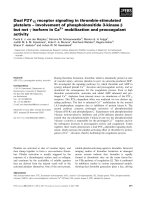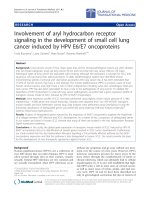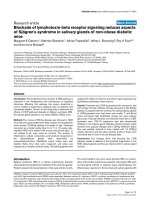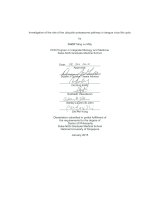ROLE OF LYMPHOTOXIN b RECEPTOR SIGNALING IN LYMPH NODE LYMPHANGIOGENESIS INDUCED BY IMMUNIZATION
Bạn đang xem bản rút gọn của tài liệu. Xem và tải ngay bản đầy đủ của tài liệu tại đây (9.74 MB, 253 trang )
ROLE OF LYMPHOTOXIN Β RECEPTOR
SIGNALING IN LYMPH NODE
LYMPHANGIOGENESIS
INDUCED BY IMMUNIZATION
NG JUN XIANG
B.Sc (Hons), NUS
A THESIS SUBMITTED
FOR THE DEGREE OF DOCTOR OF PHILOSOPHY
NUS GRADUATE SCHOOL FOR INTEGRATIVE
SCIENCES AND ENGINEERING
NATIONAL UNIVERSITY OF SINGAPORE
2013
iii
Acknowledgements
I would like to express my heartfelt gratitude to my supervisors Dr Veronique
Angeli and Prof David M. Kemeny, for their mentorship, guidance and advice
over the years. Thank you for all the opportunities and support that you have
given me. Especially Dr Veronique, who is a great mentor, friend, and sometimes
a motherly figure in the lab. Thank you for helping me through difficult times
during these few years.
I would also like to thank Dr Jean-Pierre Abastado and Dr Sylvie Alonso for their
invaluable advice and discussions on the project. I am also grateful to Dr Ge
Ruowen for giving me the chance to work in her lab during my undergraduate
days
Special thanks to Dr Daisuke Shiokawa for his words of wisdom and
encouragement.
I wish to thank my colleagues and friends in the VA lab, especially Michael,
Serena, Ivan, Karwai, Jason and Ying ni for their help and meaningful discussions
in these years.
I would also like to take this opportunity here to thank Yanting, Cynthia, Yanxin,
and Shiyan who their help and encouragement.
Last of all, I would like to thank my family for their support.
iv
Table of Contents
Acknowledgements iii
Table of Contents iv
Summary xi
List of Tables xiii
List of Figures xiv
Abbreviations xvii
Chapter 1: Introduction 1
1.1 Lymphatic Vessels 2
1.1.1 Lymphatic vasculature 2
1.1.2 Lymphatic vessels markers 3
1.1.3 Development of the lymphatic vasculature 6
1.2 Lymph nodes 8
1.2.1 Structure of the lymph node 8
1.3 Lymphangiogenesis 9
1.3.1 Lymphangiogenic growth factors & receptors 11
1.3.2 Inflammatory Lymphangiogenesis 13
1.3.2.1 Inflammation 13
1.3.2.2 Lymphangiogenesis in peripheral tissues 15
1.3.2.3 Lymphangiogenesis in lymph nodes 16
1.3.2.4 Lymphangiogenesis in tertiary lymphoid structures 22
1.4 Lymphotoxin β receptor signaling 23
v
1.4.1 Lymphotoxins and their receptors 24
1.4.2 Lymphotoxin β receptor and the NF-κB signaling pathway 27
1.4.3 Role of lymphotoxin β receptor signaling in the development &
maintenance of lymphoid structures 27
1.4.4 Lymphotoxin β receptor signaling in lymph node homeostasis and
remodeling 28
1.5 Matrix metalloproteinases 30
1.5.1 Regulation of matrix metalloproteinase activity 31
1.5.2 Role of matrix metalloproteinases in physiological & pathological
conditions 34
1.5.2.1 Matrix metalloproteinases in inflammation 35
1.5.2.2 Matrix metalloproteinases in tumorigenesis 35
1.5.2.3 Matrix metalloproteinases in angiogenesis 36
1.5.2.4 Matrix metalloproteinases in lymphangiogenesis 37
1.6 Aims & rationale 39
Chapter 2: Material & Methods 41
2.1 Mice 42
2.2 Induction of lymph node hypertrophy by immunization with complete
Freund’s adjuvant/keyhole limpet hemocyanin 42
2.3.1 Preventive inhibition 43
2.3.2 Therapeutic inhibition 43
vi
2.4 Stimulation of the LTβR signaling and the TNFR signaling pathways with
LTβR agonist and TNFR agonist 43
2.5 Subcutaneous application of MMP-13 inhibitor 44
2.6 In vivo-labeling of mouse cells with 5-bromo-2'-deoxyuridine (BrdU) 44
2.7 Transplantation of bone marrow cells 45
2.7.1 Generation of WT/WT and WT/µMT mice 45
2.7.2 Generation of WT/µMT and LTα/µMT mice 45
2.8 Dendritic Cell migration assay 46
2.9 Cells isolation 46
2.9.1 Isolation of cells from lymph nodes 46
2.9.2 Isolation of dendritic cells from lymph nodes (Dendritic cell migration
assay) 47
2.9.3 Isolation of B cells from lymph nodes 47
2.10 Flow cytometry 47
2.10.1 Immunofluorescence staining of cell surface antigens for flow
cytometric analysis 48
2.10.2 Intracellular staining of cells for flow cytometric analysis of LEC
proliferation 48
2.11 Immunofluorescence analysis 49
2.12 Polymerase chain reaction (PCR) 50
2.12.1 Total RNA extraction from mammalian cells and tissues 50
2.12.2 Reverse transcription 51
2.12.3 Semi-quantitative PCR 52
2.12.4 Quantitative real-time PCR (qPCR) 52
vii
2.13 Protein expression & analysis 53
2.13.1 BCA protein assay 53
2.13.2 Sodium dodecyl sulfate-polyacrylamide gel electrophoresis (SDS-
PAGE) 53
2.13.3 Transfer of proteins 54
2.13.4 Immunoblotting 54
2.13.5 Zymography assay 55
2.14 Cell Culture 56
2.14.1 SV-LEC 56
2.14.2 RAW 264.7 cells 57
2.14.3 HMVEC-dLy cells 57
2.15 Tube formation assay 58
2.15 Scratch wound assay 59
2.16 RNA interference (RNAi) 60
2.17 Statistical analysis 61
Chapter 3: B cells mediate lymphangiogenesis in the lymph nodes through
the expression of lymphotoxin α 62
3.1 Introduction 63
3.2 Results 65
3.2.1 Induction of LN lymphangiogenesis by CFA/KLH immunization 65
3.2.2 Requirement of B cells in the expansion of the LNs and LN
lymphangiogenesis in response to immunization 68
viii
3.2.3 Expression of LTα by B cells critical for LN lymphangiogenesis
induced by immunization 74
3.2.4 Implication of FDCs in the induction of LN lymphangiogenesis in
response to immunization 77
3.3 Discussion 83
Chapter 4: Regulation of lymph node lymphangiogenesis by lymphotoxin β
receptor signaling 85
4.1 Introduction 86
4.2 Results 87
4.2.1 LTβR signaling in the regulation of LN expansion and
lymphangiogenesis following immunization 87
4.2.2 Blocking lymphangiogenesis through the LTβR signaling pathway
hampers the enhancement of DC migration induced by immunization 94
4.2.3 Immunization induces the expression of LTα in B cells 97
4.2.4 Activation of the LTβR signaling pathway in the absence of
immunization is insufficient to trigger lymphangiogenesis 100
4.2.5 Therapeutic inhibition of the LTβR signaling does not affect LN
lymphangiogenesis 108
4.3 Discussion 118
ix
Chapter 5: Blocking lymphotoxin β receptor signaling reveals the role of
matrix metalloproteinase-13 in lymph node lymphangiogenesis 120
5.1 Introduction 121
5.2 Results 123
5.2.1 LTβR signaling regulates the expression of MMP-13 in LNs 123
5.2.2 Localization of MMP-13 and MMP-9 in the LNs 127
5.3 Discussion 149
Chapter 6: Matrix metalloproteinase-13 regulates lymphangiogenesis
through proteolytic degradation of extracellular matrix and basement
membrane 151
6.1 Introduction 152
6.2 Results 154
6.2.1 SV-LECs upregulate the expression of MMP-13 upon stimulation 154
6.2.2 Blocking MMP-13 proteolytic activity prevents tube formation by
SV-LECs 158
6.2.3 MMP-13 is not involved in the regulation of LECs proliferation 172
6.2.4 Inhibition of MMP-13 activity prevents tube formation in a primary
human LEC line 174
6.3 Discussion 177
Chapter 7: Discussion 180
7.1 LTβR signaling in B cells-mediated LN lymphangiogenesis 181
x
7.1.1 Importance of B cells in LN lymphangiogenesis 181
7.1.2 Regulation of LN lymphatic vessel growth and function by LTβR
signaling 184
7.1.3 Role of B cells in LTβR signaling 186
7.1.4 Temporal control of LTβR signaling in LN lymphangiogenesis 189
7.2 Role of MMP-13 in lymphangiogenesis 190
7.2.1 Regulation of MMP-13 expression by LTβR signaling 190
7.2.2 Compartmentalization of MMP-13 in the LNs 192
7.2.3 In vitro modulation of lymphangiogenesis by MMP-13 194
7.3 Proposed mechanims driving lymphangiogenesis in the inflamed LNs 197
7.3.1 Regulation of lymphangiogenesis through the role of MMP-13 in the
activation cascade of MMPs 199
7.4 Relevance of this study 201
7.5 Future directions 204
7.6 Conclusion 205
Reference 206
Appendix 1: List of antibodies used for flow cytometry 229
Appendix 2: List of antibodies used for immunofluorescence analysis 230
Appendix 3: List of primers used for semi-quantitative PCR 231
Appendix 4: List of primers used for qPCR 232
Appendix 5: List of antibodies used for immunoblotting 233
xi
Summary
Lymphangiogenesis is the formation of new lymphatic vessels from pre-existing
vasculature, where lymphatic vessels are important in the maintenance of tissue
fluid homeostasis and immune surveillance. During inflammation,
lymphangiogenesis can be observed in the draining lymph nodes (LNs) of
inflamed peripheral tissues. Several immune cells such as B cells, macrophages
and DCs have been linked to the induction of lymphangiogenesis in the LNs.
However, the molecular mechanism underlying the remodeling of lymphatic
vessels in the LNs during inflammation is still in its infancy. Of interest to us is
the signaling pathway behind B cells-mediated LN lymphangiogenesis, as well as
the role that the lymphotoxin β receptor (LTβR) signaling pathway may play in
regulating LN lymphangiogenesis. Although the role of LTβR signaling in the
control of splenic architecture is well recognized, aspects of the LN
microenvironment that are dependent on LTβR remain uncertain.
In this study, we showed the requirement of B cells in the expansion of the LNs
and lymphangiogenesis in response to immunization. The expression of LTα by B
cells is critical for LN lymphangiogenesis. We demonstrated that LN expansion
and lymphangiogenesis were reduced when LTβR signaling was inhibited by a
decoy receptor prior to immunization. Expression of LTα, which forms the
heterotrimer LTα
1
β
2
together with LTβ, increased in B cells after immunization.
In addition, we found that LTβR signaling only exert its regulatory role in the
early stages of lymphangiogenesis. These observations led us to investigate one of
xii
the initial steps of the lymphangiogenesis process involving the degradation of the
extracellular matrix (ECM) and basement membrane (BM) by matrix
metalloproteinases (MMPs). The role of MMPs in lymphangiogenesis to date is
not as well characterized compared to angiogenesis.
Our findings revealed that MMP-13 expression increased in the LNs after
immunization, and this expression of MMP-13 is regulated by LTβR signaling.
Study of the localization of MMP-13 in the LNs suggested that the proteinase
might be involved in driving lymphangiogenesis through the remodeling of ECM
and BM. Using a stable lymphatic endothelial cell (LEC) line, we showed that
LECs express MMP-13. Through in vitro experiments, we demonstrated that
MMP-13 mediates lymphangiogenesis through its proteolytic activites. Overall,
this study identify LTβR signaling pathway as a key molecular mediator in the B
cell-mediated lymphangiogenesis, as well as showing that LTβR signaling
regulates the expression of MMP-13 that is required for the degradation of matrix
components for sprouting of new lymphatic vessels.
xiii
List of Tables
Table 1.1: Expression and regulation of lymphotoxin, LIGHT and their
receptors 26
Table 1.2: Members of the matrix metalloproteinase family 32
Table 3.1: B cells population in the different mice group 75
xiv
List of Figures
Figure 1.1: Schematic overview of the structure and function of the lymphatic
vasculature 4
Figure 1.2: LN architecture 10
Figure 1.3: Schematic representation of lymphangiogenic growth factors and their
receptors expressed by lymphatic endothelium 14
Figure 1.4: Ligands and receptors of the tumour-necrosis factor/lymphotoxin
system 25
Figure 3.1: Expanded LNs and lymphangiogenesis 4 days after CFA/KLH
immunization 67
Figure 3.2: Expansion of the B and T cells population in the LNs after
immunization 69
Figure 3.3: Absence of lymphangiogenesis in µMT mice 71
Figure 3.4: Transplantation of B cells in µMT mice induced LN
lymphangiogenesis by immunization 73
Figure 3.5: Examination of the LV network in the LNs of the various chimeric
mice following immunization 76
Figure 3.6: Examination of the FDC network in the LNs of the various chimeric
mice 78
Figure 3.7: Effects of CFA/KLH immunization on TNFαKO mice 82
Figure 4.1: Blocking the LTβR signaling pathway inhibits LN expansion and
lymphangiogenesis following immunization 89
Figure 4.2: Expression of LTβR by LECs 91
Figure 4.3: Uncharacteristic LN lymphangiogenesis in TNFαKO mice not
regulated by LTβR 93
Figure 4.4: Blocking lymphangiogenesis through the LTβR signaling pathway
hampers the enhancement of DC migration induced by immunization 96
Figure 4.5: Differential expression of LTβR ligands by B and T cells upon
Immunization 99
xv
Figure 4.6: Activation of the LTβR signaling pathway in the absence of
immunization is insufficient to trigger lymphangiogenesis 102
Figure 4.7: Triggering both the canonical and non-canonical NF-κB pathways
by activation of TNFR and LTβR is not adequate to induce LN
lymphangiogenesis 104
Figure 4.8: Stimulation of LTβR along with immunization is not enough to initate
LN lymphangiogenesis in µMT mice 106
Figure 4.9: Effects of therapeutic inhibition of LTβR signaling for 3 days after
immunization on LN cellularity and lymphangiogenesis 109
Figure 4.10: Prolonged LN enlargement and lymphangiogenesis after
immunization 112
Figure 4.11: Effects of prolonged therapeutic inhibition of LTβR signaling for 1
week after immunization on the LNs 114
Figure 4.12: Effects of prolonged therapeutic inhibition of LTβR signaling for 2
weeks 117
Figure 5.1: Expression of MMP-2, MMP-9, MMP-13 and MT-MMP in LNs 124
Figure 5.2: Proteolytic activites of MMP-9 and -13 in the LNs 126
Figure 5.3: Localization of MMP-13 in the LNs 130
Figure 5.4: Localization of MMP-9 in the LNs 136
Figure 5.5: Localization of types I and IV collagen in the LNs with respect to
compartmentalization of MMP-9 and -13 141
Figure 5.6: Effect of blocking LTβR signaling on MMP-9 and -13 and type I and
IV collagens in the LNs 146
Figure 6.1: Expression of MMP-2, -9, -13 and MT1-MMP in SV-LECs after
stimulation by TNFα 155
Figure 6.2: Expression of MMP-2, -9, -13 and MT1-MMP in RAW cells after
stimulation by TNFα 157
Figure 6.3: Spontaneous tube formation of SV-LECs on matrigel 160
Figure 6.4: Effects of different MMP inhibitors on tube formation of
SV-LECs 162
xvi
Figure 6.5: Live-cell imaging of the effects of blocking MMP-13 on the tube
formation process by SV-LECs 164
Figure 6.6: Effects of blocking MMP-13 on wound closure by SV-LECs in the
scratch wound assay 166
Figure 6.7: Effects of silencing MMP-13 with siRNA on tube formation 169
Figure 6.8: Effects of stimulation of LTβR and TNFR signaling on tube
Formation 171
Figure 6.9: Effects of blocking MMP-13 on LECs proliferation 173
Figure 6.10: Blocking MMP-13 inhibits tube formation in a primary
human LEC 176
Figure 7.1: Diagram depicting the possible pathways of lymphangiogenesis
mediated by LTβR signaling 198
Figure 7.2: Proposed model of how the various MMPs may work to stimulate
lymphangiogenesis upon LTβR stimulation in a cascade 200
xvii
Abbreviations
ALK activin receptor-like kinase
AM adrenomedulin
Ang angiopoietin
APC antigen-presenting cell
APC allophycocyanin
Aspp apoptosis stimulating protein of p53
BAFF B cell activating factor
BEC blood endothelial cell
BM basement membrane
BrdU 5-bromo-2'-deoxyuridine
BSA bovine serum albumin
CALCRL calcitonin receptor-like receptor
CD cluster of differentiation
CFA complete Freund’s adjuvant
CCL chemokine (C-C motif) ligand
CCR chemokine (C-C motif) receptor
CXCL chemokine (C-X-C motif) ligand
Cy cyanine
DC dendritic cell
DcR decoy receptor
DMEM Dulbecco’s modified Eagle’s medium
DTH delayed-type hypersensitivity
EDTA ethylenediaminetetraacetic acid
ECM extracellular matrix
xviii
FACS fluorescence activated cell sorting
FBS fetal bovine serum
FDC follicular dendritic cell
FGF fibroblast growth factor
FGFR fibroblast growth factor receptor
FITC fluorescein-5-isothiocyanate
FLT4 fms-related tyrosine kinase 4
FRC fibroblastic reticular cell
HBSS Hank’s Buffered Saline Solution
HEV high endothelial venule
HGF hepatocyte growth factor
HMVEC human microvascular endothelial cells
HRP horseradish peroxidase
HVEM herpesvirus entry mediator
ICAM intercellular adhesion molecule
IFN interferon
Ig immunoglobulin
IGF insulin-like growth factor
IL interleukin
JAK Janus kinase
KLH keyhole limpet hemocyanin
LEC lymphatic endothelial cell
LIGHT lymphotoxin-like, exhibits inducible expression, and
competes with herpes simplex virus glycoprotein D for
herpesvirus entry mediator
LN lymph node
xix
LT lymphotoxin
LTβR lymphotoxin β receptor
LYVE-1 lymphatic endothelial hyaluronan receptor
MACS magnetic activated cell sorting
MAdCAM mucosal vascular addressin cell-adhesion molecule
MAPK mitogen activated protein kinase
MMP matrix metalloproteinase
mRNA messenger ribonucleic acid
MT-MMP membrane-type matrix metalloproteinase
NF-κB nuclear factor-kappaB
Nrp neurophilin
PBS phosphate buffered saline
PCR polymerase chain reaction
PDGF platelet derived growth factor
PE phycoerythrin
PerCP peridinin-chlorophyll protein
PNAd peripheral lymph node addressins
Prox1 prospero-related homeobox 1
qPCR quantitative real-time polymerase chain reaction
RAMP receptor activity-modifying protein
RPMI Roswell Park Memorial Institute
SDS-PAGE sodium dodecyl sulfate-polyacrylamide gel electrophoresis
siRNA short interfering RNA
SLP SH2 domain containing leukocyte protein
Src proto-oncogene tyrosine-protein kinase
STAT signal transducer and activator of transcription
xx
Syk Spleen tyrosine kinase
TCR T cell receptor
TGF transforming growth factor
TNF tumor necrosis factor
TNFR tumor necrosis factor receptor
VEGF vascular endothelial grow factor
VEGFR vascular endothelial grow factor receptor
WT wild type
1
Chapter 1: Introduction
2
1.1 Lymphatic Vessels
The blood vasculature transports oxygen and nutrients, carrying out exchange of
molecules and removal of waste products to and from the tissues. In this process,
hydrostatic and osmotic pressure gradients cause plasma from the blood
capillaries to enter the surrounding interstitial space. This extravasation of fluids
and proteins from the blood vessels is balanced by a second vascular system, the
lymphatic vascular system. The lymphatic vasculature drains and returns this fluid
(lymph) back to the bloodstream. Unlike the pressurized circulatory system of the
blood vasculature, there is no central pump in the lymphatic vascular system and
the lymphatic vasculature is a hierarchical network of vessels with a unidirectional
lymph flow from the periphery back to the blood circulation. The major roles of
the lymphatic vasculature comprise the maintenance of tissue fluid homeostasis,
immune surveillance and fat absorption in the small intestine (Oliver and Alitalo,
2005).
1.1.1 Lymphatic vasculature
The lymphatic vessels are part of the lymphatic system, which also includes the
lymphoid organs, such as the lymph nodes (LNs), spleen, thymus, Peyer’s patches
and the tonsils. The lymphatic vasculature consists of five main categories of
conduits: the lymphatic capillaries (or initials), collecting vessels, LNs, larger
trunks and the thoracic duct (Swartz, 2001). The initial lymphatic capillaries that
begin blind-ended in the periphery are made up of a single layer of lymphatic
endothelial cells (LECs) and have a wider lumen compared to blood capillaries
3
(Swartz and Skobe, 2001). There is incomplete coverage of the lymphatic
capillaries by basement membrane (BM) and, in its place, the LECs are attached
to the surrounding extracellular matrix (ECM) through anchoring filaments that
prevent the capillaries from collapsing (Gerli et al., 1990; Schmid-Schönbein and
Schmid-Schönbein, 1990; Pflicke and Sixt, 2009). Interstitial fluid first enters the
lymphatic capillary plexus through discontinuous button-like junctions between
the LECs (Baluk et al., 2007). From there, lymph is drained into the collecting
vessels. The collecting lymphatic vessels, unlike the lymphatic capillaries, are not
anchored to the ECM. Instead, they contain perivascular smooth muscle cells that
facilitate the propulsion of lymph, as well as valves that prevent retrograde flow
(Figure 1.1) (Schmid-Schönbein and Schmid-Schönbein, 1990; Bridenbaugh et
al., 2003; Randolph et al., 2005). The collecting vessels then pass through one or
several clusters of LNs leading into the larger trunks, before draining into the
thoracic duct where the lymph is discharged into the blood circulation.
1.1.2 Lymphatic vessels markers
Although the lymphatic system has been observed centuries ago, and its anatomy
nearly entirely characterized by the 19
th
century, our understanding of the
lymphatic system advanced at a much slower rate compared to the blood
circulatory system in the last century (Swartz, 2001). This is primarily due to the
fact that lymphatic vessels are difficult to distinguish from blood vessels
histologically. Furthermore, the majority of blood vascular markers can also be
found in the lymphatic vessels (Sleeman et al., 2001). It is only with the discovery
4
Figure 1.1: Schematic overview of the structure and function of the lymphatic vasculature. (Adapted from Mol Aspects Med, 32(2),
Paupert et al., Lymphangiogenesis in post-natal tissue remodeling: lymphatic endothelial cell connection with its environment, 146-58,
copyright 2011 with permission from Elsevier) Endothelial cells of lymphatic capillaries have an oak shaped with overlapping scalloped
edges (flaps). These flaps are only sealed on the sides by discontinuous button- like junction (BJ) allowing fluid entry through these flaps
without disturbing cell–cell cohesion. Immune cells (lymphocytes (L), macrophages (M), dendritic cells (DC)) likely enter lymphatic
capillaries through the intermingled flaps. In contrast to BV, interstitial matrix constitutes the principal microenvironment of initial
lymphatic since they are devoid of a continuous basement membrane (BM). Anchoring filaments connect lymphatic capillaries to
extracellular matrix and modulate vessel diameter by pulling adjacent endothelial cells apart. Lymphatic vessels (LV), lymphatic
endothelial cells (LEC), blood vessels (BV), blood endothelial cells (BEC), fibronectin (FN), hyaluronan (HA).
5
of specific LEC surface markers, as well as specific molecules that govern the
development and growth of lymphatic vessels, that allowed advances and
understanding of the lymphatic system (Oliver and Detmar, 2002).
Among the first lymphatic markers to be characterized is the vascular endothelial
growth factor receptor-3 (VEGFR-3), also known as the fms-related tyrosine
kinase 4 (FLT4), together with its ligand VEGF-C (Kaipainen et al., 1995; Kukk
et al., 1996). During early embryonic development, VEGFR-3 was observed to be
expressed in both the developing venous and the presumptive lymphatic
endothelia (Kaipainen et al., 1995). However in adult tissues, VEGFR-3 is
expressed mainly in the lymphatic endothelium, unlike VEGFR-1 and VEGFR-2
which are found on both the blood and lymphatic endothelia (Kaipainen et al.,
1995; Veikkola et al., 2000; Kriehuber et al., 2001). Following that, a specific
marker on the surface of LECs and macrophages was identified as the lymphatic
endothelial hyaluronan receptor (LYVE-1) (Banerji et al., 1999). As the name
suggests, LYVE-1, a CD44 homolog, is a receptor for hyaluronan. Hyaluronan is
an ECM glycosaminoglycan that is abundantly found in the skin and
mesenchymal tissues where it has roles in cell adhesion and cell migration
(Knudson and Knudson, 1993; Jiang et al., 2011). With the discovery of the
LYVE-1 marker on LECs, the lymphatic vessels have been visualized in tissue
sections from several tissues including the skin (Skobe and Detmar, 2000).
Another surface marker that can also be used to identify the lymphatic vasculature
is podoplanin (Wetterwald et al., 1996; Breiteneder-Geleff et al., 1999).









